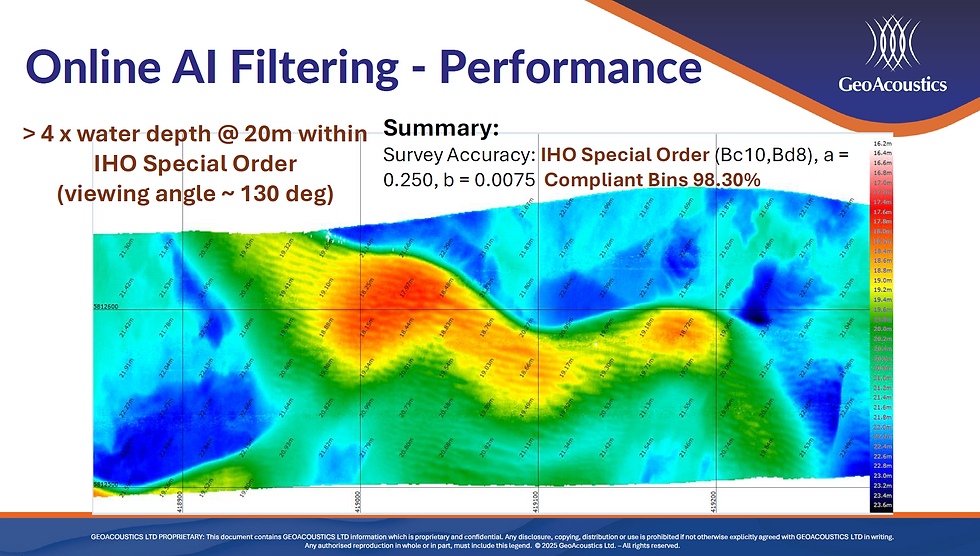AI and Wide Swath Bathymetry in Focus at Subsea Innovation Day 2025
- saul trewern
- Sep 17
- 2 min read

Taking place on 4th September in Åkrehamn, Norway, the RTS and Norwegian Forum for Offshore Survey and Positioning (NOSP) organised Subsea Innovation Day 2025 provided a platform for a broad spectrum of subsea technology manufacturers and users. Among the presentations, GeoAcoustics’ Francisco Gutiérrez offered a technically rich session on the use of AI in bathymetric data processing, which included a primer on wide swath bathymetric systems and a compelling case study of how artificial intelligence is reshaping workflows and quality control for modern hydrography.
There are fundamental differences between the two primary classes of wide swath bathymetric systems. Multibeam echo sounders (MBES) are used in many offshore applications and rely on beamforming techniques and physical aperture limitations that can constrain coverage in shallow water. Phase-measuring bathymetric sonars (PMBS), use interferometric principles that allow for much wider swath coverage, up to 12 times water depth, making them especially suitable for shallow water mapping, coastal monitoring, and infrastructure inspection.

AI-based Innovation
GeoAcoustics’ GeoSwath 4 is one of the few true PMBS, and it's here that GeoAcoustics has delivered a true innovation. Through a multi-year joint development project with the University of East Anglia, the GeoSwath 4 system now has integrated AI-based real-time quality control and automated data cleaning directly in its processing chain. Unlike traditional approaches that rely heavily on manual editing of filters and operator judgement, GeoSwath 4’s AI capabilities assess quality during acquisition, identify and discard outliers, and provide intuitive feedback to the operator in real time.
The AI engine at the heart of the system is trained not on synthetic data, but on actual user-collected surveys, enabling it to distinguish between true seabed features and spurious returns such as noise from vessel motion or water column scatter. The project to develop the AI was not just an academic exercise in automation. It has delivered tangible operational advantages such as fewer post-survey corrections, faster turnaround from acquisition to chart-ready data, and more reliable outputs in complex environments.

AI-powered workflow
To make the most of these capabilities, the Subsea Innovation Day audience was walked through a recommended workflow for GS4 users. It begins with acquisition, which simply requires the user to select their required survey accuracy IHO specification and enable the online AI filter. When transmitting, operators can optimise ping lengths, adjust the limits filter, and set line spacing. The steps for the minimal post-processing of the AI’s quality-controlled output, as well as how to quickly produce the final data products followed, painting a complete picture of a faster, much simplified workflow, thanks to the power of AI.
What emerged clearly was a message that AI, when purpose-built and field-trained, is a practical enhancement to survey quality and efficiency. Especially for PMBS systems like GeoSwath 4, where automating high-density data and wide coverage delivers operational and data quality improvements. In bridging the gap between classic interferometry and modern AI science, GeoSwath 4 shows how established acoustic principles can evolve with the times, making this a perfect topic for another successful Subsea Innovation Day.


